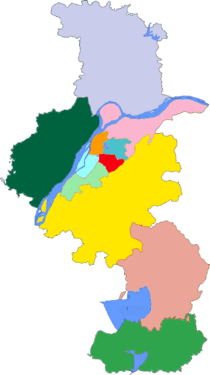Nanjing Fuzimiao
| Nanjing Fuzimiao | |
|---|---|
|
Native name Chinese: 南京夫子庙 | |
 Kuiguang/Kuixing Pavilion (魁光阁/魁星阁) | |
| Location | 128 Zinyhan Road, Nanjing, China |
| Coordinates | 32°01′21″N 118°47′02″E / 32.022579°N 118.783786°ECoordinates: 32°01′21″N 118°47′02″E / 32.022579°N 118.783786°E |
| Built | 1034 originally A.D.; the current structure was built in the 19th century |
Nanjing Fuzimiao (Chinese: 南京夫子庙) or Fuzimiao (Chinese: 夫子庙; literally: "Confucian Temple"), is located in southern Nanjing City on banks of the Qinhuai River. Within the area are cultural attractions, arts, shopping, and entertainment. Rather than being a place of quiet reflection and study, the area has become a tourist trap of the first order, overrun with people and souvenir shops and with prices to match. If you wish to go inside the temple, you must buy a ticket for 30RMB (as of July 2018).
History
In first year of Jianwu reign of Jin Dynasty (CE 317), Nanking Imperial University was founded, initially on northern bank of Qinhuai River, and in the 3rd year of Xiankang (CE 337) the campus extended to southern bank. Temple of Confucius was firstly constructed in the national school in the 9th year of Taiyuan (CE 384). The place was later destroyed. In the 1st year of Jingyou during Song Dynasty (CE 1034), Confucius Temple was newly constructed on former site of imperial university, and was called Fuzimiao area along with Nanking Fuxue.[1][2] The place became Imperial University again in 1365 in the early year of Ming Dynasty, and sixteen years later recovered to be the campus of Fuxue. During Qing Dynasty, there were two Xianxue (county schools of Shangyuan and Jiangning) in Fuzimiao area. In the end of Qing a primary school jointly sponsored by counties of Nanjing (Jiangning Fu) was established there. The current buildings date from the 19th century, in Qing Dynasty, with additions made since then. The temple lost all financial support by the state as a result of the revolution of 1911. During the late 1920s to 1931 and again in 1932 it was used as army barracks for troops the KMT regime and left in a dilapidated state. Some halls were used as picture gallery.[3] In 1985 Fuzimiao area was restored.
There is Jiangnan Gongyuan near Fuzimiao Temple. It's the largest imperial examination hall in Ming and Qing dynasties.
Throughout its history, the temple along with the around area has been a place for study of Confucianism. There is a small exhibit of folkart within the temple.[4]
Directions
Take Nanjing Metro Line 1 to Sanshanjie Station. Use Exit 3, turn right onto Shengzhou Road. Cross the next big street, continue on Jiankang Road. Walk past the traditional gate to the small square with the park, turn right onto the pedestrian shopping street (look for the signs of the famous coffee and ice cream chain stores). Walk all the way to the end of that street. The temple is on the large square opposite the wall with the yellow dragon.
Gallery
 Confucius sculpture
Confucius sculpture Lingxing Gate (棂星门)
Lingxing Gate (棂星门) Great Spirit Screen (大照壁) decorated with a dragon
Great Spirit Screen (大照壁) decorated with a dragon Streetview north of Zhonghua Gate
Streetview north of Zhonghua Gate Riverside near Fuzi Miao
Riverside near Fuzi Miao Night view of Qinhuai River and Fuzimiao
Night view of Qinhuai River and Fuzimiao Another night view of Qinhuai River and Fuzimiao, where both Kuiguang Pavilion and Great Spirit Screen (on the opposite riverside of each other) can be seen
Another night view of Qinhuai River and Fuzimiao, where both Kuiguang Pavilion and Great Spirit Screen (on the opposite riverside of each other) can be seen
References
| Wikimedia Commons has media related to Fuzi Miao. |
- ↑ Fuzimiao
- ↑ Nanjing Fuzimiao
- ↑ Krug, Hans Joachim (*1893); Wanderungen und Wandlungen in China; Berlin 1941 (Scherl), p. 44-5, 53 (based on a visits 1930-3)
- ↑ DK Eyewitness Travel Guide: China. DK Publishing; 1 June 2012. ISBN 978-0-7566-9328-2. p. 222.
